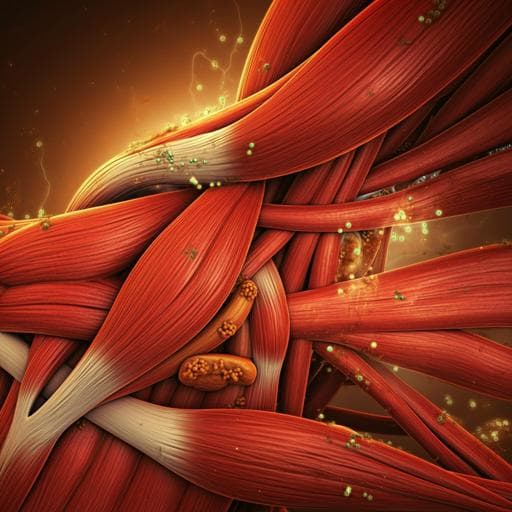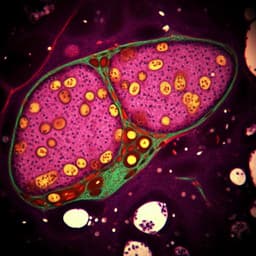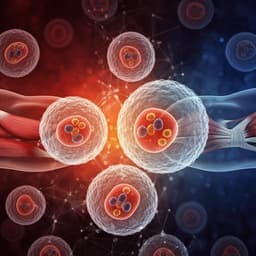
Health and Fitness
Age-dependent impact of two exercise training regimens on genomic and metabolic remodeling in skeletal muscle and liver of male mice
M. Bernier, I. N. Enamorado, et al.
This groundbreaking study led by Michel Bernier and colleagues explores how age and different exercise training regimens, like HIIT and MICT, affect genomic and metabolic changes in male mice. Discover how older mice benefited from moderate training, enhancing body composition and muscle strength while unveiling the age-dependent adaptations in skeletal muscle. A tailored exercise approach for the elderly could be on the horizon!
~3 min • Beginner • English
Introduction
The study addresses how aging and exercise modality interact to influence skeletal muscle structure, function, and systemic metabolism. Aging leads to sarcopenia and declines in mitochondrial biogenesis, bioenergetics, dynamics, and respiratory capacity, with reduced anabolic signaling (mTORC1) and insulin sensitivity in skeletal muscle. Exercise is known to counteract many age-related deficits, improving protein synthesis, insulin signaling, mitochondrial function, and bioenergetics. Fuel utilization differs by exercise intensity (carbohydrates at high intensity; fatty acids at moderate intensity), and skeletal muscle-liver-adipose crosstalk supports substrate supply during exercise. High-intensity interval training (HIIT) can yield fitness gains with less time than moderate-intensity continuous training (MICT). The purpose was to compare adaptive responses to daily HIIT versus MICT over 4 weeks in adult (5 months) and old (24 months) male C57BL/6J mice, testing systemic physiology, muscle mitochondrial structure/function, muscle transcriptomics, and liver/serum metabolomics to determine age- and regimen-dependent benefits.
Literature Review
Prior work shows aging-associated loss of muscle mass/strength (sarcopenia) and remodeling of skeletal muscle structure and metabolism in humans and rodents. Molecular hallmarks include impaired mitochondrial biogenesis, bioenergetics, dynamics, and respiratory capacity; blunted nutrient- and insulin-induced mTORC1 signaling; insulin resistance; and lipid accumulation correlating with reduced strength. Exercise training enhances protein synthesis irrespective of age, restores insulin signaling and mTORC1 activation, improves mitochondrial markers and respiratory supercomplex assembly, and benefits muscle bioenergetics (ATP production, NAD+ homeostasis, pyrimidine biosynthesis). Fuel selection during exercise depends on intensity and duration, with early reliance on intramuscular stores and progressive uptake of circulating substrates; lactate/glycerol serve hepatic gluconeogenesis. Time for exercise declines with age; HIIT can improve cardiorespiratory fitness comparably to MICT with less time. However, transcriptomic/metabolomic adaptations to different exercise modalities in older populations are less characterized, motivating the present multi-level analysis.
Methodology
Design: Cross-sectional study in male C57BL/6J mice, adult (5 months) and old (24 months), randomized to sedentary control, HIIT, or MICT (n=9 per age×group). Standard chow ad libitum; 12:12 light:dark; 20–22 °C. Training: daily for 4 weeks (4:00–5:00 PM) on treadmill at ~30° incline. HIIT: three 2-min bouts at 27 m/min with 1-min active recovery at 5 m/min. MICT: single 45-min run at 13 m/min. Sedentary mice experienced comparable handling/noise exposure. Treadmill work (J/day) = body weight (kg) × treadmill speed (m/min) × % grade × time (min). Phenotyping: Body composition by TD-NMR at baseline and post-training; fasting blood glucose (6 h or 3 h depending on context), lactate, serum insulin, HOMA-IR. Indirect calorimetry: CLAMS Oxymax chambers, 12 h acclimation then 48 h recording, VO2, VCO2, RER, energy expenditure (EE), ambulatory activity; ANCOVA used to adjust EE for body mass; energetic cost of locomotion computed from VO2 per kg and activity counts. Neuromuscular tests: forepaw grip strength and wire hang (time to fall). Tissue collection: blood and multiple organs harvested; skeletal muscles snap-frozen; gastrocnemius processed for histology and TEM. Electron microscopy: gastrocnemius red and white regions examined; subsarcolemmal (SSM) and intermyofibrillar (IMF) mitochondria imaged at 25,000×; stereology for mitochondrial fractional area (Fa), numerical density (Na), size, and circularity (n=4–5 animals/group). Biochemistry: Western blotting of muscle lysates (10 µg/lane) for PGC-1α, SIRT1, SIRT3, Fis1, VDAC1, LC3; OXPHOS components (NDUFB8, SDHB, UQCR2, MTCO1, ATP5A); normalization by Ponceau S; n=8/group. Enzyme activities: citrate synthase (CS) and respiratory chain complexes I–IV, I+III, II+III in total homogenates; activities normalized to CS; n=5/group. Coenzyme Q: total and redox state (CoQ9, CoQ10) in quadriceps by HPLC with electrochemical detection; red/ox ratios calculated; n=5/group. Transcriptomics: Gastrocnemius RNA microarrays (Agilent SurePrint G3 Mouse GE 8x60K); Z-normalization, PCA; significant genes by z-test p<0.05, FDR<0.30, z-ratio>|1.5|, ANOVA p<0.05; PAGE for GO term enrichment; n=3–4/group. qPCR validation: eight genes; PCA on Z-scores; primers in Supplementary. Cytokines: multiplex ELISA (9-plex) on muscle extracts; n=5/group. Metabolomics: Untargeted GC-MS of liver and serum (3 h fasted); 171 identified metabolites analyzed; PLS-DA and Pearson correlation patterns for age and exercise effects; pathway enrichment/topology via MetaboAnalyst; two-way ANOVA to separate age vs exercise vs interaction. Statistics: Normality by D’Agostino–Pearson; one-way ANOVA or Kruskal–Wallis with Tukey/Dunnett post-hoc where appropriate; two-way ANOVA with Sidak for TEM; ANCOVA for EE vs body mass; significance p≤0.05. Data integration: hierarchical clustering and PCA of Z-normalized physiological, biochemical, and serum metabolomics metrics.
Key Findings
- Whole-body physiology and activity: In old mice, 4-week MICT reduced body weight and percent body fat, increasing lean:fat ratio; adult mice showed no significant body composition changes. Old mice exhibited decreased 6-h fasting blood glucose after training; insulin and HOMA-IR unchanged across groups. Indirect calorimetry revealed lower RER in old vs adult sedentary mice (light: 0.889±0.036 vs 0.937±0.042, p=0.046; dark: 0.914±0.025 vs 0.961±0.035, p=0.012), indicating greater fat utilization. ANCOVA-adjusted predicted EE at 30 g body mass decreased in old mice with both HIIT and MICT, not in adults. Old MICT mice had higher cage activity than old HIIT and sedentary groups; energetic cost of locomotion was lower with MICT vs HIIT in old mice. Wire hang time improved in old MICT mice; grip strength unchanged.
- Mitochondrial structure/function in muscle: TEM showed minimal training effects on mitochondrial morphology/abundance; in white fibers, mitochondrial circularity decreased in old vs adult sedentary mice; Fa lower in adult MICT vs HIIT. Protein markers: PGC-1α increased in adult HIIT/MICT and old MICT; SIRT3 elevated in adult HIIT/MICT; SIRT1 increased in old MICT. Fis1 increased with exercise in both ages; VDAC1 increased in adult HIIT but decreased in old MICT. LC3-II/LC3-I ratio increased in adult MICT and in exercised old mice, indicating enhanced autophagosomal activity. OXPHOS proteins: UQCR2 (CIII) up in adult HIIT; NDUFB8 (CI) up in old HIIT; SDHB (CII) elevated with MICT regardless of age; CIV and CV proteins unchanged. CS activity decreased with training in both ages. ETC activities (normalized to CS): Adults—HIIT increased CI, CIII, CIV, and I+III; MICT increased CII and II+III. Old—HIIT increased CII and I+III; MICT increased CII and II+III. CoQ redox: Sedentary old had higher CoQH2/CoQ ratios (lower efficiency); exercise reduced CoQ9 and CoQ10 red/ox ratios in old, not adults; total CoQ pools unchanged.
- Skeletal muscle transcriptomics: PCA separated old from adult; exercise minimally impacted adult transcriptome but altered old muscle, with old MICT clustering closer to adult. GO enrichment revealed many shared terms moving in opposite directions between ages. MICT produced the most gene set changes. In Old-Adult comparisons, sedentary old muscle upregulated inflammatory/defense/immune pathways, whereas old MICT upregulated translation, RNA splicing/spliceosome, proteostasis, and OXPHOS. Muscle contraction gene set (GO:0006936) strongly enriched with MICT in old vs adult (Z=5.1611; p=8.75e-07; FDR≈1.03e-05). qPCR validated microarray patterns. Cytokines showed regimen- and age-specific changes (e.g., increased IL-6 in adult MICT; IL-10 in old HIIT; CXCL1 in old MICT); no fibrosis markers changes.
- Muscle metabolic proteins: IRS-1 increased in adult MICT and in both old exercise groups; HKII accumulated in adult HIIT and old exercised muscle; PKM and CPT1b increased in both ages with exercise; HADHSC increased in adult MICT only; LKB1 upregulated with exercise.
- Liver and serum metabolomics: Age was a strong discriminator within each regimen (PLS-DA). In old liver: HIIT enriched TCA intermediates; MICT showed enrichment of lipids/lipid-related metabolites (palmitic, oleic, myristic; pantothenic acid; glycerol) and pronounced depletion of glucose metabolites (glucose, glucose-1P/6P, fructose-6P, ribose, sorbitol, glycerol-α-P). Serum across groups showed lipid enrichment; amino acid (AA) depletion prominent in adult/CON, with mixed AA/glucose changes in HIIT/MICT. Exercise-dependent patterns: Adult liver exhibited depletion of many AAs; old liver under exercise showed enrichment of AAs (phenylalanine, valine, aspartate, methionine, proline, urea) and lipid-related metabolites, with depletion of glucose-pathway metabolites—suggesting a shift from glucose toward lipid/AA utilization in old. Pathway analysis (exercise effect) highlighted aminoacyl-tRNA biosynthesis, arginine biosynthesis, AA metabolism, pantothenate/CoA and glycerolipid pathways; age effects included unsaturated fatty acid synthesis, glutathione metabolism, multiple AA pathways, and aminoacyl-tRNA biosynthesis. Integrated clustering/PCA identified age (PC1=52.0%) as dominant and training regimen (PC2=18.4%) as secondary drivers, with MICT conferring the clearest benefits in old mice.
Discussion
The findings demonstrate that exercise modality and age interact to shape systemic physiology and tissue-specific adaptations. Four weeks of daily MICT produced broad benefits in old mice, including improved body composition, fasting glycemia, activity, and neuromuscular performance, alongside bioenergetic remodeling in skeletal muscle and metabolic reprogramming in liver. Muscle mitochondria exhibited enhanced functional signatures (elevated complex II-driven flux and improved CoQ reoxidation, increased PGC-1α, SIRT3, mitophagy/autophagy markers) without major morphological changes, indicating functional optimization rather than biogenesis-driven abundance increases. Transcriptomics in old muscle showed MICT-specific upregulation of translation, RNA splicing, proteostasis, and OXPHOS pathways, while suppressing inflammation/immune signatures prevalent in sedentary aged muscle; this aligns with improved muscle function markers (IRS-1, HKII, PKM, CPT1b, LKB1). Liver metabolomics indicated an exercise-induced substrate shift in old mice, with increased lipid and amino acid pathway engagement and reduced glucose-pathway intermediates, consistent with sustained energy supply during continuous moderate exercise and with muscle respiratory chain remodeling. Collectively, these data support tailored exercise prescriptions, favoring moderate continuous training to counteract age-associated declines by coordinating muscle genomic and hepatic metabolic adaptations.
Conclusion
Moderate-intensity continuous training (MICT) over 4 weeks elicited superior, age-dependent benefits compared with HIIT in male C57BL/6J mice, particularly in old animals. Benefits encompassed improved body composition and glycemic control, increased spontaneous activity and wire hang performance, enhanced muscle mitochondrial function (notably complex II-linked respiration and CoQ redox efficiency), and robust transcriptomic remodeling favoring proteostasis, translation, RNA splicing, and OXPHOS while suppressing inflammatory pathways. Liver and serum metabolomics revealed exercise-specific reprogramming toward lipid and amino acid utilization in old mice, indicating coordinated multi-organ substrate handling to meet sustained energy demands. Future research should test both sexes and additional strains, extend training duration, include middle-aged cohorts, assess circadian timing of exercise, dissect adipose tissue contributions and weight-loss confounding (e.g., pair-feeding), and implement longitudinal designs to define translatable mechanisms.
Limitations
- Sex and strain: Only male C57BL/6J mice were studied; sex differences and other genetic backgrounds were not assessed.
- Exercise matching and duration: Protocols were chosen to match old mice capacity; 4-week duration may be insufficient for adult adaptations; lack of a middle-aged cohort.
- Circadian factors: Potential effects of exercise timing and circadian rhythms on substrate utilization and adaptation were not examined.
- Adipose tissue and weight loss: Adipose responses were not measured; weight loss in old MICT mice may confound molecular findings; pair-feeding not implemented.
- Study design/statistics: Cross-sectional (not longitudinal); sample size not predetermined a priori; investigators not blinded.
- Generalizability: Mouse findings may not directly translate to humans; environmental and dietary factors controlled in laboratory conditions may differ from real-world settings.
Related Publications
Explore these studies to deepen your understanding of the subject.







